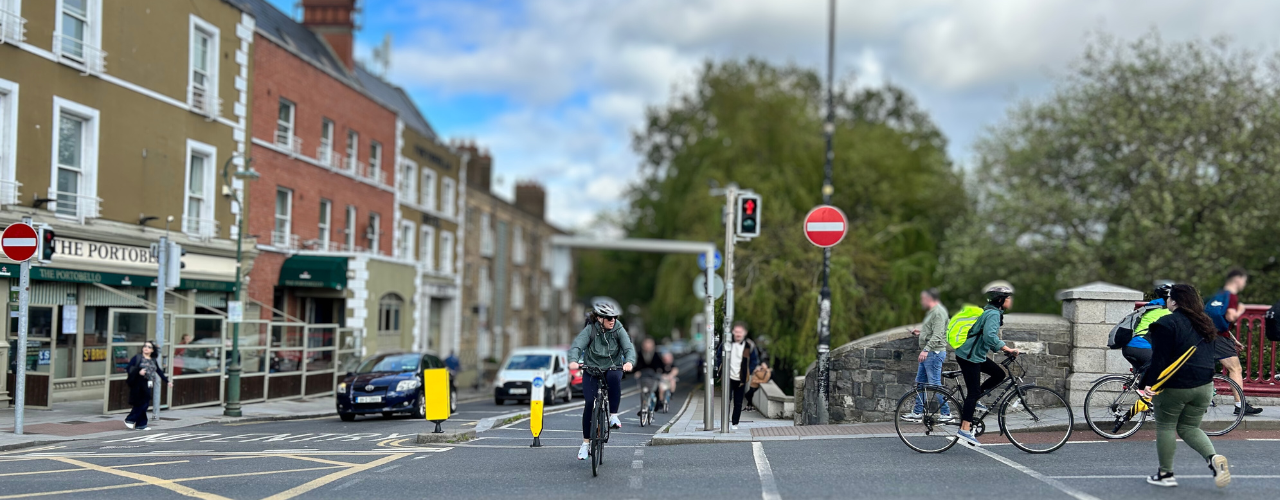
Stop de Kindermoord
‘Stop de Kindermoord’, or ‘Stop the Child Murder’ was a road safety campaign in the Netherlands during the 1970s. It precipitated the widespread installation of active transport infrastructure for which the Netherlands is now famous. This campaign was led by parents who feared for the safety of their kids, and communities who were shocked by the high numbers of deaths and official inaction. Its success resulted in the installation of active transport infrastructure. This prioritised the safety and independence of all people travelling through cities, towns and villages. The additional benefits of this movement were reduced reliance on cars, reduced emissions improving air quality, as well as the increased independence of children.
Many people in Ireland are asking and campaigning for transport infrastructure which is less centred on cars. They do this for a myriad of reasons but the safety of every person— especially those who do not have the protection of a 1500kg metal box around them—is one of the highest priorities. While the reasons for campaigning may vary, the response is largely, and depressingly, the same. Moves made to increase safety for cyclists or restrict the dominance of cars are met, by some, with strong opposition, distain and refusal to accept that alternatives are possible. Maintaining the status quo is often, conversely, touted as the only option not to destroy communities. While in reality our regressive infrastructure is leading to soaring road deaths and serious life-changing injuries
Status quo v Safe infrastructure
Opposition to individual routes has widespread and negative impacts. Creating a network of active transport is critical to creating a viable alternative to driving. Individual routes need to connect to others so all types of journeys become possible. Until then people who walk or cycle are forced to share the road with drivers who fail to see or accommodate non-vehicular road users. Safety and poor infrastructure are important factors in determining if someone choses to cycle or drive. Feeling unsafe, or encountering near misses, are incredibly common on Irish roads. This has resulted in a collapse in the numbers of kids cycling and walking to school. Continuing low numbers of people also choose not to commute in this way.
There is devastatingly high number of deaths on our roads, including the recent death of a carer cycling to visit a patient. A bicycle was the obvious choice to travel between patients ensuring punctuality and predictable travel times. Her death is continued evidence of infrastructure (and city and town planners) not prioritising the health and safety of people who choose a different mode of travel than a car. People cycling, those who are walking to their destination or to their bus or train or even their car are all exposed to this lethal environment.
Different perspectives of a dangerous environment
People experience this hostile environment to different degrees. Those with disabilities who need to use wheelchairs or canes can be particularly vulnerable. Parents pushing buggies or desperately keeping kids at their side on footpaths and people cycling who are often forced to mingle with the largest of vehicles with massive blind spots (yet rear stickers commonly shift the responsibility to cyclists) are also well aware of the dangers. However, this experience is so common that it has become normalised.
Yet this lack of awareness, or wilful ignorance, around the danger that motor vehicles pose to people results in some fairly shocking incidences of victim blaming and finger pointing. For some, it is not the road design, or large trucks in urban centres but bicycles themselves that are dangerous. Not wearing hi-vis during daylight is akin to asking to be hit by a car while cycling a foot from the kerb is intentionally antagonising drivers.
Another reality is possible
Yet, we don’t need to go far, or use much imagination, to find alternatives. Anyone who has been to cities such as Utrecht in the Netherlands, Pontevedra in Spain, Oslo in Norway and Ghent in Belgium have public space prioritising people and active transport rather than private cars. Milan, Stockholm and Paris are also considering limiting the access of cars into the city centre. Even here in Ireland there are spaces without cars which can be used as examples of what is possible. Dun Laoghaire has made great strides in making the coast more accessible. Several towns experimented with car free streets during Covid, breathing life back into urban centres. This also created safe spaces for families and communities to eat or shop or simply be.
We need to change how our towns and cities are laid out. We need to create environments that is safe for people to travel how they wish.
Better infrastructure encourages children to walk or cycle to school under their own steam and offers alternatives for people who currently drive. The longer we continue to avoid this reality, the more engrained car dominance will become.
Plan for imperfection
Messaging alone does not work in the long term. People are still using phones while driving despite large previous media campaigns and continuous appeals. We cannot control for every factor that makes driving dangerous including drinking, speed, tiredness, distraction. We also cannot expect walkers and cyclists to be perfect on the road. Wind and uneven surfaces will cause wobbles past the thin painted line which sometime acts as a ‘cycle lane’. Kids can and do pull away from parents or trip and fall into the path of cars. Designing these different users to mingle in a mess of car dominated infrastructure will always result in fatalities.
The unwillingness to inconvenience drivers and deliver active transport infrastructure has unequal consequences. Drivers continue to sit in more traffic, while pedestrians and cyclists—particularly the young and the old—are dying.

